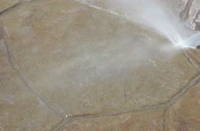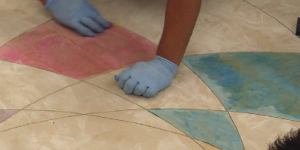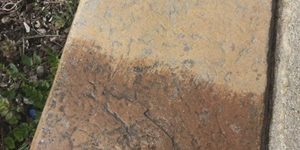Resealing exterior decorative concrete is probably the most misunderstood and least-studied process in our industry. It has the potential to be a repeat revenue stream or a headache that never really goes away. I must admit, in the past 15 years I’ve become more guarded on the recommendations I hand out in regard to resealing. I used to be quick with advice for any job, no matter how far gone the sealer. “Just clean it and reseal every year or two” is still the standard advice I hear regarding resealing.

I believe this “one size fits all” strategy for resealing is a significant reason for many of the sealer issues the industry faces today. I also believe that manufacturers and installers alike need to focus more attention on the process of resealing, as well as the strategies and recommendations they provide to clients. Today I am much more cautious when it comes to resealing instructions, usually recommending that the surface be stripped of all existing sealer. That advice never goes over well, as there are not many jobs as miserable as stripping sealer from stamped concrete. I get that, but experience has taught me that if you are not 100 percent certain of what is on the surface, or the job is not in good condition, stripping is the best way to go.
I’m not sure where or when I heard it first, but the saying, “no matter what was done before you, the last one to touch a job, owns it,” has long been one of my standard lines. This could not be truer than when it comes to resealing.
What should you look for when it comes to the go/no-go decision of taking on a reseal job? Most important, and the one you should never ignore, is your internal voice. Always listen to that “little voice” inside your head or the “gut” feeling that says run if it doesn’t feel right.
Understanding acrylics
Since 95 percent of exterior decorative concrete work is sealed with acrylic products (cure and seal or sealer), we will focus on those sealer systems. When you look at the chemistry of resealing, you must understand two key processes: cohesion and adhesion. Adhesion is the bonding force a material has to another substance, such as sealer to concrete. Cohesion is the bonding force between the same substances, such as one sealer molecule to another sealer molecule.
When a sealer is applied, we need good cohesion of the sealer molecules to each other to form the sealer film, while we also need good adhesion of the sealer film to the concrete. When resealing, both adhesion and cohesion may take place depending on the sealer type. This is where solvent-based acrylics literally and figuratively outshine water-based sealers.
Solvent-based sealers applied directly over existing solvent sealers can melt or reliquify the original sealer coat. This allows the two to become one, giving a solvent-based reseal the benefit of both cohesion and adhesion. Water-based sealers don’t have the solvent strength to melt or reliquify the initial coat, so they only exhibit adhesion when resealing.
A lack of cohesion or adhesion is the primary culprit for reseal failures. This often occurs if the existing sealer film is dirty, contaminated, already in failure or is just too thick. Keep in mind that acrylics are designed to be a thin film (1 to 3 mils) and year-after-year resealing increases the thickness and stresses the sealer, eventually leading to premature failure.
Factors to consider
Here are a few key factors to help you determine whether you should reseal exterior decorative concrete:
Too often the job doesn’t need to be resealed. In many cases plenty of sealer still remains and the issue is more about the owner’s desire to have that clean, shiny, new look back. Adding coat after coat of sealer, year after year, only to bring back gloss is a recipe for disaster. Look into sealer rejuvenators which restore shine without increasing sealer thickness.
Slow down. Unless it has been 10 years since the last sealer was applied, or the surface has been stripped or never been sealed, chances are there is more sealer there than you can see. Most reseals are applied just like the first application. This usually doesn’t provide enough time for one coat to adhere to the first. With solvent-based acrylics it takes 60 to 90 seconds for the new reseal coat to wet out the existing sealer. This involves slowing down, working small areas, rolling the reseal into the existing sealer and lots of patience.
Resealing can’t fix a bad job. Resealing will not fix issues with the concrete, such as color failure or efflorescence. Too often I get called on jobs where a reseal is failing, and now the installer and owner are dealing with two issues — the original problem and a failing reseal. Understanding and identifying issues before resealing are critical. If in doubt, walk away or strip the sealer to address the root of the problem.
Resealing will not fix flaking and/or chipping sealer. It took me years to finally learn that once the sealer starts delaminating from the concrete, resealing is only a Band-Aid. You may improve the look for a little while, but the original sealer issue still exists and it will come back, typically worse than ever.
Manage your client’s expectations. Too often homeowners are under the misconception that their stamped concrete patio, which is subject to wind, rain, dirt and sun, should still look shiny and new two years after it was initially sealed. The response usually involves resealing to restore gloss, when rejuvenating or cleaning is all that’s needed.
Think tires! Do you replace tires on your vehicle every year, no matter their condition? I doubt it. Most people replace tires when the tread is worn. That can vary based on the tires, how much and on what they are driven. Same goes for sealers. Reseal when the sealer is gone, not based on the calendar.
Look at other options. Products like sealer rejuvenators, stains and penetrating sealers are becoming popular because they bring life back to dull and worn sealers. Penetrating sealers can add waterproofing and stain-resistant properties to existing sealers. They are not a magic fix, but they do offer an alternative to just throwing more sealer on the surface.
I want to be clear that I’m not advocating every job be stripped or that you should avoid resealing. I think the industry as a whole should pay more attention to the process of resealing, better understand the products, and better educate and manage clients on what to expect long term from exterior sealed decorative concrete. When you consider how much stamped concrete is out in the market, the percentage of sealer-related complaints and failures is actually pretty low. We just hear about the problem jobs.
I suggest you pick and choose reseal jobs with a very tight set of parameters. You’ll probably walk away from more than you agree to take. Expand your toolbox of products, and don’t enter into any job before seeing it. Treat each case independently, look at the symptoms, diagnose the problem and follow through with a well thought-out solution.















